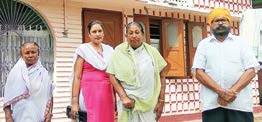
Emperor Maharaja Ranjit Singh of Sikh kingdom might have never imagined that descendants of 500 Sikh soldiers whom he had sent to Assam to fight Burmese invaders in 1822 would mitigate recurring annual floods 195 years later with Sikhism’s essential free kitchen or ‘langar’ at Barkola village in central Assam’s Nagaon district.
“Barkola village is situated a bit upland because of which it becomes an island every year during floods. When neighbouring villages get inundated, residents come in boats to seek shelter in the four gurdwaras and schools of Barkola. We provide free food to the victims in the langars of the four gurdwaras of the village. As government relief comes late and in scant amount, we villagers ourselves share whatever food we have. We survive because of this cooperation,” said Kartara Singh, president of Nanak Sahi gurdwara in the village.
Located some 15 km south of Nagaon town, Barkola boats 10,000 residents out of which 2,000 are Sikhs, mostly Dalit Mazhabis. Tiwa and Koch tribals, Assamese Dalit communities such as Hiras and Kaibartyas and OBC Nath Jugis make up rest of the population.
Prolonged isolation from Punjab has made the Sikhs closer to Assamese communities that with other Sikhs.
“We speak Assamese, call ourselves Assamese Sikhs and intermarry with Assamese Hindus. The then Punjab chief minister Giani Jail Singh along with Surjit Singh Barnala had visited Assam in 1975 to meet us. Learning that we can’t speak Punjabi, he had requisitioned Siromani Gurdwara Prabandhak Committee (SGPC) of Amritsar and sent one Giani Bhajan Singh of Anandpur Sahib to teach us Gurumukhi script in 1979. He married a local Assamese Sikh woman, lived with us for 30 years and died recently after retirement,” Kartara Singh added. However, since then the SGPC has not assisted the Assamese Sikhs in the maintenance of gurdwaras or development of the community kitchens.
Courtesy: The New Indian Express














